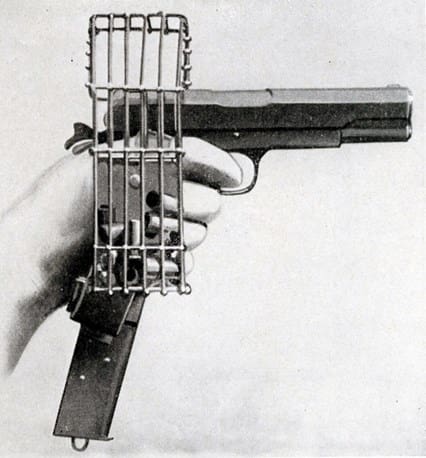Airplanes were still relatively new when they were pressed into service during World War I. Because of this, a number of hurdles had to be overcome to ensure that this new machine could become a weapon of war and not a casualty of war. The biggest hurdle became obvious right away . . .
without an interrupter gear, the machine guns will cut through the propellers and the plane will crash. Another hurdle: hot brass.
Any shooter who’s spent some time on the range knows that hot brass can be quite uncomfortable and disruptive. The last thing anyone needed during an aerial dogfight was for the pilot to become distracted by a piece of hot brass landing somewhere it shouldn’t.
Errant brass could also prove to be detrimental to the plane’s equipment itself. If a piece (or pieces) got caught in the mechanical workings of the plane, it could have a catastrophic result.
Enter cartridge catchers.
These devices fit onto the frame of a pistol, situated to the right and rear of the ejection port. This enabled the brass to be ejected as normal and caught safely in the metal trap. The shooter could now engage the enemy — yes, while flying the aircraft — without worrying about burning himself or his co-pilot, or possibly jamming any of the plane’s operational parts.
These days Air Force pilots carry the standard 9mm Beretta with extra magazines. No cartridge catchers need apply.
Logan Metesh is a firearms historian and consultant who runs High Caliber History LLC. Click here for a free 3-page download with tips about caring for your antique and collectible firearms.




Weapons carried by aircrew today are not meant to be used in the air. No need for brass catchers.
If modern aircrew are using their sidearms they are having a really bad day.
I’m surprised that hasn’t been in a Michael Bay movie yet:
The F-15 gets hit and the pilot ejects. The Mig turns and heads straight toward the American pilot. The American draws his pistol, misses a few shots, concentrates, has a flashback sequence of his wife, then fires his final round. We jump cut to the Mig cockpit, where we hear the cracking of glass and see the pilot get hit in the helmet.
Long as the pistol don’t transform.
Oooh! Transforming pistol! Now that would be a good movie.
/sarc
This kinda happened:
https://m.warhistoryonline.com/world-war-ii/right-jumped-out-of-his-crippled-b-24-shot-down-a-zero-with-his-m1911-whilst-in-his-parachute.html/2
He had a .45. You can’t shoot down a zero with a 9mm. Duh. Everybody knows this.
https://www.youtube.com/watch?v=osGfGK3zgf0 already seen it.
oh yeah she can snipe a pilot in a jet going supersonic speeds hundreds of yards away but heaven forbid she hit a soldier 60m away sprinting parallel to her or actually aim for a guy’s face and not his magical bulletproof helmet
I have to wonder if a 9mm (much less a .9mm) would go through a fighter jet’s canopy.
Those cockpits are bird-strike rated, so pretty substantial.
Most strikes would be at an angle, so would ricochet away. The strike would need to be perpendicular to the canopy, and then I wonder if it would go through with enough energy to kill the pilot.
Hmmm… I should email Mythbusters.
Or Demolition Ranch.
We know that frozen chickens will go through the windshield of a Cessna.
I read that the biggest threat to WWI planes was the landing. Far more crashed while trying to land than got shot down or had mechanical problems.
*ahem*
“Revolvers.”
*walks back to his lunch*
🤠
Bloving: Bless your cylindrical retaining heart!
So, were these brass catchers attached to handguns which the pilots used to shoot at other planes? Or did mechanics install brass catchers on the machine guns mounted to the fuselage of the planes?
Side note: I just realized that the brass casing of tapered cartridges approximates a teardrop shape and would probably achieve a pretty dangerous velocity during free fall from a couple thousand feet up. Anyone ever heard of any damage to anyone or anything on the ground from falling brass casings?
I don’t know if it happened for reals, but there’s a “don’t be this guy” WWII era training video that shows a guy knocking a civilian out with a negligently ejected cartridge during training. So it’s certainly a danger they thought about.
That is a pretty sweet extended mag for that era
The sky rained twenty Mike Mike shells and a soldier said “corpse man, corpse”
Comments are closed.